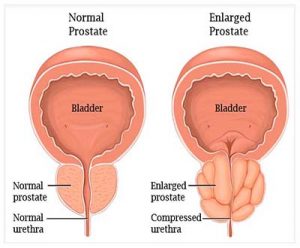- October 17, 2021
- Posted by: Dr. Devendu Shah
- Category: urologist
Prostate enlargement or benign prostatic hyperplasia (BPH) or benign enlargement of the prostate(BEP) is one such situation that is common after the age of 50 years in men. Let us examine some facts and myths about the prostate gland.

The prostate gland is a walnut-shaped gland situated below the bladder and usually develops in size as the age progresses. Two growth spurts occur in attention to the prostate gland, one at puberty and others next to the age of 30 years. But the signs of prostate enlargement start manifesting clinically only after the age of 50 years.
As the prostate enlarges it reduces the urinary tube called the urethra leading to many urinary symptoms. The bladder tries to compensate for it by working hard trying to force urine out. Ultimately, the bladder gets fatigued and the amount of urine retained raises to such an extent that the patient lands in the emergency unit with complete inability to pass urine. Any cases may continue to dribble urine with discomfort. Few patients may land up with urinary tract infection or bladder stones. Few unfortunate ones may land up in reflux nephropathy and kidney failure.
Do you know the notice signs and symptoms of prostate enlargement? These are the basic things to be looked at,
Increase the number of urination at night – to be a precise extension number of times getting up from bed during sleep.
- Extended day time-frequency
- Urgency
- Urinary incontinence
- Burning while passing urine
- Delayed start of urination
- Poor stream of urine
- A thin stream of urine
- Sense of incomplete urination
- Interrupted stream
After thorough medical and rectal research, the urologist may ask for an ultrasound abdomen, urine tests, and few blood tests. You may be also asked to undergo a uroflow rate and/or urodynamic test.
Besides medical therapy for the prostate, if need be, we have (HOLEP) laser treatment for removal of the prostate.
Advantages of laser prostatectomy over conventional treatment are,
- Less blood loss
- Quick recovery
- Less hospitalization
- Less pain post-op
- Can be operated on patients with anticoagulants/blood thinners
- Can be operated on patients with pacemakers
- Can be operated on high-risk patients
- Can be operated for even large-sized glands with safety
The myth – Size matters. No, it doesn’t! This is the largest myth about an enlarged prostate. Big symptoms may indicate a small enlargement and vice versa. The severity of the signs simply does not always correlate with size.
Also, while the symptoms suggest an enlarged prostate, they might indicate other situations that require further examination. Symptoms of an enlarged prostate, for example, can be similar to those of prostate cancer. See urologists and put your fear behind.
